Consumer Electronics Show 2005: AT's Coverage
by Anand Lal Shimpi on January 10, 2005 3:49 AM EST- Posted in
- Trade Shows
1080p DLPs Coming in April
Texas Instruments was quite eager to showcase all of the DLP based rear projection TVs that use their DLP chips.
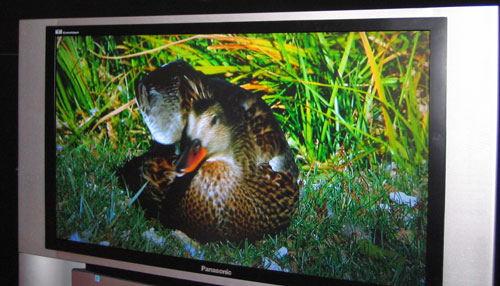
Panasonic's 720p DLP
The most exciting thing at the TI booth however were the handful of displays that used TI's new xHD3 DLP - their first 1080p (1920 x 1080 progressive) DLP solution.

A 1080p image
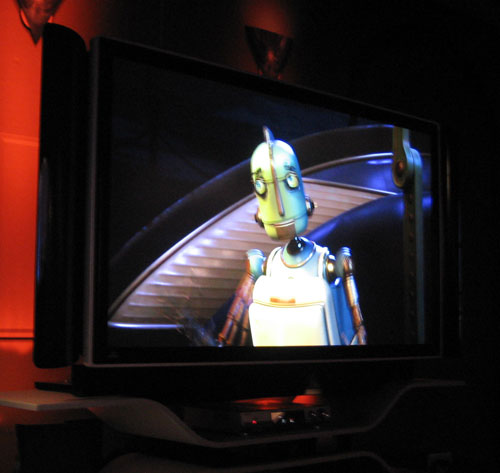
A 70" 1080p DLP
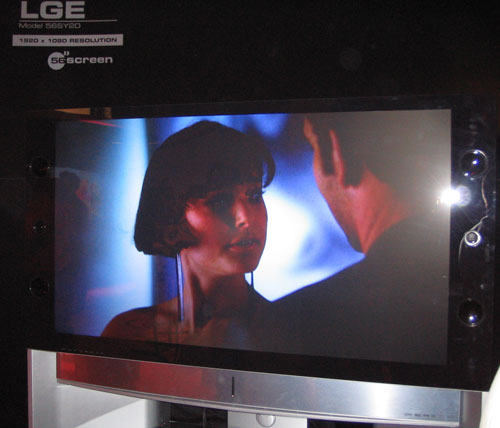
LGE's 1080p display
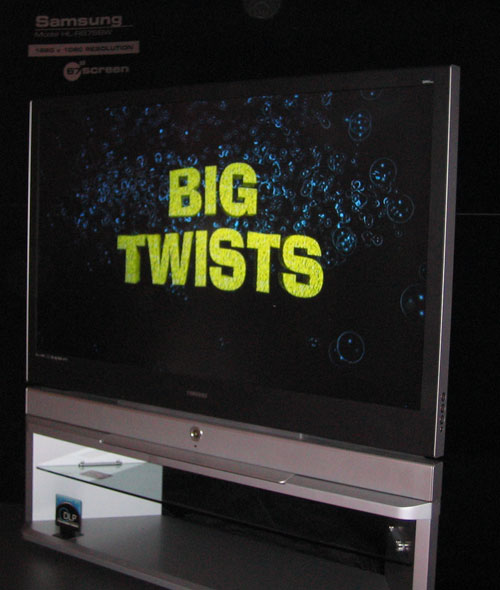
Samsung's 67" 1080p DLP priced at over $6000 and available in April
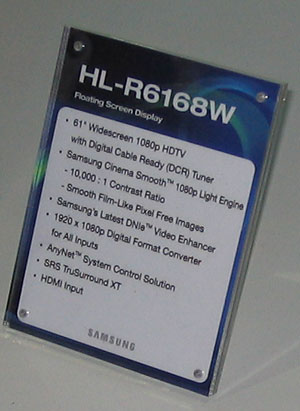
Samsung will also offer a 61" 1080p DLP
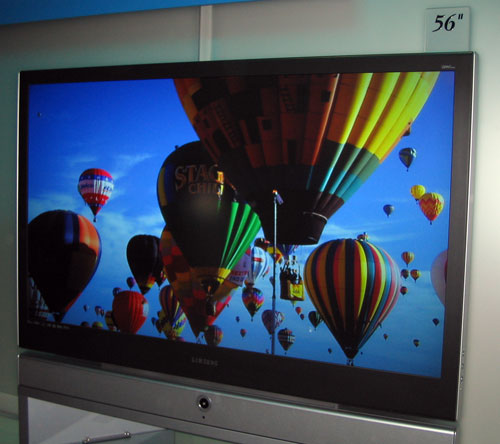
Samsung's 56" 1080p DLP also due out in April
TI also gave us a rundown of their current DLP lineup to clear up any confusion there may be over the cost/features of various TI solutions in DLPs today:
HD2 - TI's older DLP measures 0.8" diagonally and is a rectangular grid 720p DLP.
HD2+ - A higher contrast version of the HD2. The higher contrast was made possible through process improvements allowing for closer positioning of the individual mirrors, smaller mirrors and darker coatings to help absorb unwanted light inside the DLP.
HD3 - A 0.55" diagonal die not on a rectangular grid using half the mirrors of the HD2/HD2+ but still a 720p solution. Using mirrors that can move and stabilize at twice the speed of the HD2+ solution, TI was able to use each mirror for two pixels in the HD3 chip by shifting each individual mirror very slightly and very quickly to paint two pixels (think of it as a serial DDR approach to DLPs). The benefit of using half the mirrors is that it drives down the size of the DLP (0.55" vs. 0.8") and thus reduces the price of the TVs. The DLP also somewhat overlaps the two pixels it paints using a single mirror to get rid of pixelization, to provide for a smoother, more film-like image (which some may or may not prefer). TI calls this 2 pixels per mirror technology their Smooth Picture Technology, so whenever you see that phrase used it means that the TI DLP is only using half the necessary mirrors and using each mirror to drive 2 pixels.
xHD3 - A larger chip with a 0.85" die, the xHD3 is basically a HD3 that does 1080p. It also features Smooth Picture Technology.
Samsung displays based on the xHD3 DLP will be out in April, and available in sizes ranging from 56" up to 67".










48 Comments
View All Comments
sprockkets - Monday, January 10, 2005 - link
Forget using a DLP television, I want a DLP projector on a 100"+ screen.Oh well each has its advantages and disadvantages.
Better not have any stationary images on a plasma I've heard :)
snorre - Monday, January 10, 2005 - link
#23: Well, so you're telling me that the Inquirer are deceiving us then whey reported the following less then a month ago:http://www.theinquirer.net/?article=20211
"The good news for all of you Sound Storm 2 supporters is that Nvidia decided to get this audio back. It just prematurely announced it, as it will take Nvidia at least nine months to put it back to Southbridge. The decision has been made.
Soundstorm 2 will come back but not before roughly the "fall" of 2005."
AtaStrumf - Monday, January 10, 2005 - link
To my displeasure ATi has managed to get at least one product with their new RS300 chipset for Intel out the door. It's called:SHUTTLE ST62K ZEN Barebone
It's could have been a fine product IF only they made it a little bigger so they could put in a PSU, which would enable them to power a graphics card in which case they would actually put in an AGP slot, which they didn't, hence it's a freakin' dead end machine if a word 3D games is in your vocabulary. The on-board 9100 IGP isn't as horrible as I feared, but it sure isn't what you would want to be stuck with, especially at that price.
Why the hell get that thing them? Why not just get a laptop instead?!?!
Do these people even think when designing such products?!?!
Enough ranting.
bob661 - Monday, January 10, 2005 - link
#24It ain't happening. SS is dead and long gone. Accept it. Wallow in it. Order out for more.
Richthofen - Monday, January 10, 2005 - link
#23well The Nvidia CEO seems to tell a different story at least during the last conference call :)
I don't believe for a second either that Nvidia is out of the sound business. They are out of that business right now but that doesn't have to be the case in the future.
I would expect a comeback from them in the sound business once they have made a big step into the Intel chipset business or when they manage to combine sound technology with GPU technology.
Reflex - Monday, January 10, 2005 - link
#9: This has been confirmed multiple times for months now. In fact, the SoundStorm team was completely disbanded before the release of NF3 almost two years ago.I have stated it multiple times, its been both officially and unofficially confirmed before as well. I work for a large software company that has extensive dealings with nVidia. Specifically I work in the audio group, and believe me, the nVidia guys are long gone.
You don't have to believe it, but we are now two chipsets past the last SS enabled one and a lot of people don't quite get it that SS is dead and buried. Will they continue to post about it when the nForce9 is released..?
thraxes - Monday, January 10, 2005 - link
#14While technically correct that the gases in Plasmas wear out with extended use, the effect is hardly noticeable.
I work in a TV studio where we use Pioneer Plasmas and professional grade Barco DLP-RP monitors. The Barcos and the Pioneers have both been in almost continuos use for at least 8-12 hrs every day since 2001. Guess what: The Plasmas are still way way brighter than the DLPs. In fact, the DLPs are probably going to be replaced soon by... plasmas.
Reasons:
1: Brightness - especially when the DLPs are visible on Camera and need to show graphs etc. they are very lacking. Plasmas are bright enough for this and more importantly - camera angle independent. This is even after running them 12 hrs/day for 4 years.
2: Cost of ownership. Run these machines over 12 hours a day EVERY DAY and the money starts to add up. The DLPs are slightly less expensive to buy but need the lamp replaced every few months which is comes to a significant amount of money over the lifetime of the unit. Energy consumption of DLP vs. Plasma is identical at about 400W. The DLP loses out because of your perceived advantage of "just changing the light bulb".
Phantronius - Monday, January 10, 2005 - link
Grrrr no PCI express cards till mid time this year? WTF is this?SunLord - Monday, January 10, 2005 - link
This is amusing but do we have any proof it was a dualcore and not just a dual system they called a dual core?thraxes - Monday, January 10, 2005 - link